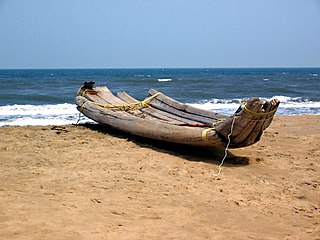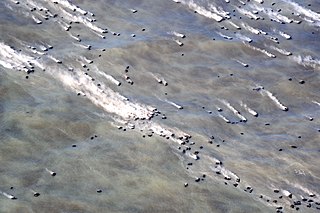 W
WA raft is any flat structure for support or transportation over water. It is usually of basic design, characterized by the absence of a hull. Although there are cross-over types that blur this definition, rafts are usually kept afloat by using any combination of buoyant materials such as wood, sealed barrels, or inflated air chambers, and are typically not propelled by an engine.
 W
WIn early periods of North American industrial development, an ark was a temporary boat used for river transport in eastern North America before slack-water canals and railroads made them obsolete. Because they could be built using relatively crude hand tools, Arks were built in American colonial and early republic times, primarily to carry cargo downriver on the spring freshets, and especially to carry milled lumber, charcoal and other forest products and bulk agricultural produce to a city or a port downriver; while logs were often tied into rafts, on long trips which could take weeks, the rafts would be accompanied by such arks as crew support quarters. Deep rivers allowed large log arks such as is described below instead of less controllable rafts. Since by 1800, most eastern towns and cities were short on heating fuels, even badly processed timber or planks could readily be sold at the destinations.
 W
WA junk raft is a type of home-built watercraft made of plastic bottles or other recycled materials constructed by artists and community-minded groups organizing recreational flotillas, or by environmentally concerned individuals seeking to draw attention to the problem of floating debris and the need for recycling. It can also be an improvised small, functional watercraft from readily available materials.
 W
WKattumaram (கட்டுமரம்) is a traditional Tamil watercraft used in the Coast of Southern India, Sri Lanka, and Bangladesh,. They are characterized by being made from three to seven tree trunks tied together with fiber lashings and/or treenails. The lashings are not permanent and the individual tree trunks are commonly separated to dry under the sun when kattumaram are beached. Most kattumaram are rafts because they are not watertight and rely on the buoyancy of the individual logs. However, some types of kattumaram known as teppa are watertight due to the addition polystyrene fillings on the hull and thus are true boats. They are propelled by oars, paddles, or lateen or lug sails. Modern versions of the kattumaram made from fibreglass are known as "fibre-teppa".
 W
WThe Kon-Tiki expedition was a 1947 journey by raft across the Pacific Ocean from South America to the Polynesian islands, led by Norwegian explorer and writer Thor Heyerdahl. The raft was named Kon-Tiki after the Inca god Viracocha, for whom "Kon-Tiki" was said to be an old name. Kon-Tiki is also the name of Heyerdahl's book, the Academy Award-winning 1950 documentary film chronicling his adventures, and the 2012 dramatized feature film nominated for the Academy Award for Best Foreign Language Film.
 W
WThe Kon-Tiki2 Expedition built and sailed two balsawood rafts from Peru to Easter Island in 2015. The goal of the expedition was to show that balsawood rafts can be sailed across long distances, and to collect scientific data in the southeast Pacific. The expedition built two rafts in 30 days and went on to sail the rafts more than 2000 nautical miles before reaching Easter Island after 43 days at sea. No other balsa rafts have sailed to Easter Island in modern times.
 W
WKotta mara is a type of floating battery or fortified raft from Borneo. It is used by native Bornean in warfare, its usage rose prominently during the Banjarmasin war (1859-1906). Kotta mara is used in riverine warfare, as an armed vessel or simply a blockhouse or fortification to prevent enemy advance in the river.
 W
WA lava balloon is a gas-filled bubble of lava that floats on the sea surface. It can be up to several metres in size. When it emerges from the sea, it is usually hot and often steaming. After floating for some time it fills with water and sinks again.
 W
WA lifeboat or liferaft is a small, rigid or inflatable boat carried for emergency evacuation in the event of a disaster aboard a ship. Lifeboat drills are required by law on larger commercial ships. Rafts (liferafts) are also used. In the military, a lifeboat may double as a whaleboat, dinghy, or gig. The ship's tenders of cruise ships often double as lifeboats. Recreational sailors usually carry inflatable liferafts, though a few prefer small proactive lifeboats that are harder to sink and can be sailed to safety.
 W
WA pumice raft is a floating raft of pumice created by some eruptions of submarine volcanoes or coastal subaerial volcanoes.